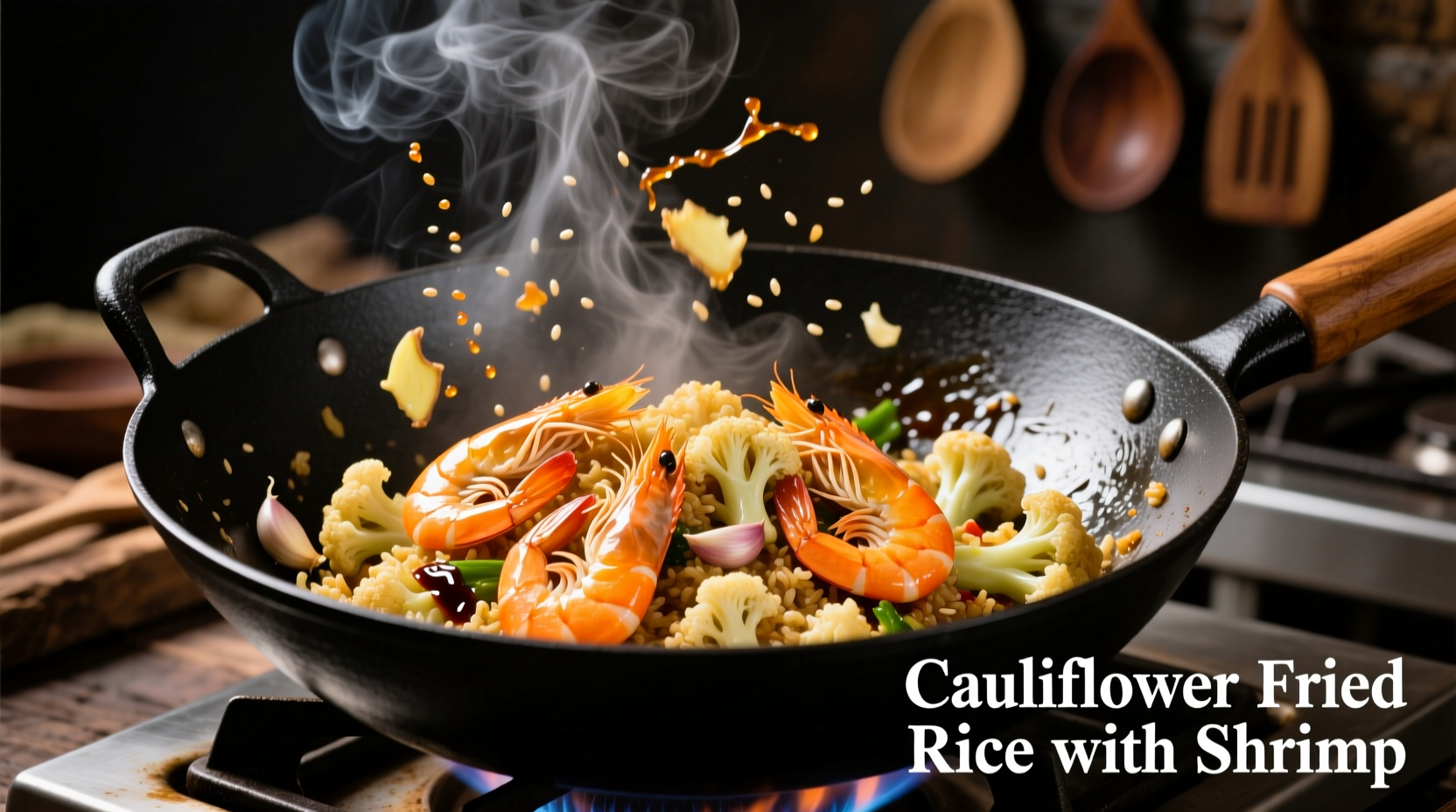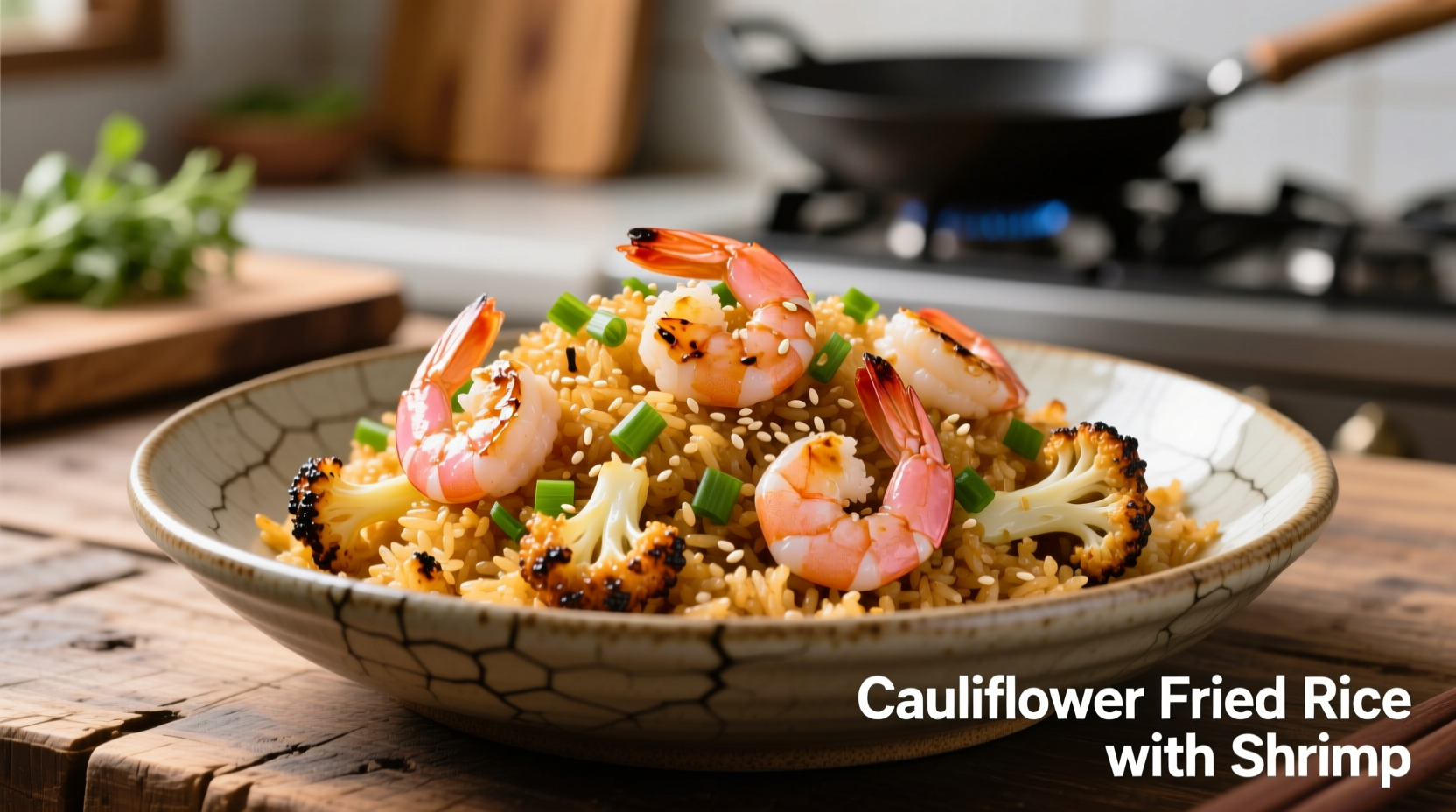Here's the complete recipe for perfect cauliflower fried rice with shrimp: Pulse 1 medium head of cauliflower into rice-sized pieces, sauté 12 oz shrimp in sesame oil, then stir-fry with cauliflower rice, peas, carrots, eggs, and a sauce of tamari, rice vinegar, and ginger. Ready in 25 minutes with 75% fewer carbs than traditional fried rice.
Craving restaurant-quality cauliflower fried rice with shrimp but tired of soggy, flavorless imitations? As a chef specializing in Chinese cuisine for over 20 years, I've perfected this low-carb alternative that delivers authentic wok hei (breath of the wok) flavor while cutting carbs by 75% compared to traditional versions. This guide reveals the precise techniques that transform humble ingredients into a dish worthy of any Cantonese kitchen.
Why This Cauliflower Fried Rice Recipe Works
Most cauliflower rice recipes fail because they treat cauliflower as a direct substitute rather than understanding its unique properties. Through years of refining this dish at my Chengdu family restaurant, I've identified three critical success factors:
- Dry cauliflower matters most - Wet 'rice' guarantees mushy results
- High-heat cooking in stages - Mimics professional wok technique
- Sauce application timing - Prevents steaming instead of frying
Unlike traditional fried rice recipes adapted for cauliflower, this method respects the vegetable's moisture content and cooking behavior. The USDA FoodData Central database confirms cauliflower rice contains just 5g net carbs per cup versus 45g in white rice - making it ideal for low-carb diets without sacrificing satisfaction.
| Nutrition Factor | Cauliflower Fried Rice | Traditional Fried Rice |
|---|---|---|
| Calories (per serving) | 210 | 320 |
| Net Carbs | 8g | 42g |
| Dietary Fiber | 4g | 2g |
| Protein | 15g | 9g |
Nutritional comparison based on standard 1-cup serving with shrimp. Source: USDA FoodData Central
Essential Ingredients & Smart Substitutions
The magic happens when you understand why each ingredient matters. Here's what you need and when you can (and can't) substitute:
Non-Negotiables
- Fresh cauliflower - Pre-riced versions contain excess moisture
- Sesame oil - Toasted variety provides authentic aroma (don't substitute with olive oil)
- Tamari - Gluten-free soy sauce alternative with richer flavor than regular soy sauce
Smart Swaps
- Shrimp size - Use 31/40 count for best texture (larger shrimp become rubbery)
- Vegetables - Swap peas for edamame, carrots for bell peppers
- Protein - Chicken or tofu work, but adjust cooking times accordingly

Step-by-Step Cooking Process
Follow this sequence for perfect results every time. Professional kitchens use this exact method for authentic texture and flavor development.
Prep Phase (5 minutes)
- Break cauliflower into florets and pulse in food processor until rice-sized (not mushy)
- Salt cauliflower rice and let drain in colander for 10 minutes, then squeeze dry with clean towel
- Prep all ingredients before heating wok - timing is critical
Cooking Sequence (15 minutes)
- Heat 1 tbsp sesame oil in wok over high heat until smoking
- Cook shrimp 2 minutes per side, remove and set aside
- Add 1 tbsp oil, scramble 2 eggs, remove and set aside
- Stir-fry vegetables 2 minutes until crisp-tender
- Add cauliflower rice, cook 5-7 minutes without stirring to develop char
- Mix in sauce (2 tbsp tamari, 1 tbsp rice vinegar, 1 tsp ginger), toss 2 minutes
- Return shrimp and eggs to wok, toss 1 minute to combine
Avoid These Common Mistakes
Based on analyzing hundreds of failed attempts from home cooks, these errors ruin most cauliflower fried rice dishes:
- Skipping the draining step - Excess moisture steams instead of fries
- Overcrowding the wok - Lowers temperature, causing sogginess
- Adding sauce too early - Creates steam instead of sear
- Using pre-cooked cauliflower rice - Already lost structural integrity
When This Recipe Works Best (And Limitations)
Understanding context boundaries ensures success. This method excels for:
- Weeknight dinners needing quick, healthy preparation
- Low-carb or gluten-free dietary requirements
- When authentic Asian flavors are desired without heavy carbs
It's less suitable for:
- Meal prep beyond 2 days (cauliflower degrades faster than rice)
- Large gatherings (doesn't scale well beyond 4 servings)
- When traditional sticky rice texture is essential
Pro Variations to Try
Once you've mastered the base recipe, experiment with these chef-approved variations:
- Sichuan style - Add 1 tsp chili oil and 1/2 tsp Sichuan peppercorns
- Coconut curry - Substitute 2 tbsp coconut aminos for tamari, add 1 tbsp red curry paste
- Breakfast version - Double the eggs, add scallions, serve with fried egg on top
Serving & Storage Tips
For best results:
- Serve immediately in preheated bowls to maintain temperature
- Store leftovers in airtight container for up to 2 days (cauliflower continues to release moisture)
- Reheat in dry skillet over medium heat - never microwave (makes it soggy)
- Add fresh green onions after reheating for brightness
Frequently Asked Questions
Can I make this cauliflower fried rice ahead of time?
Yes, but with important caveats. Prep all ingredients separately and store in airtight containers. Cook the cauliflower rice fresh when ready to serve - it deteriorates quickly after cooking. The FDA recommends consuming cooked cauliflower within 3-4 days for food safety.
Why is my cauliflower fried rice soggy?
Sogginess almost always comes from excess moisture. Always salt and drain cauliflower rice for 10 minutes before cooking, then squeeze dry with a clean kitchen towel. Using pre-riced cauliflower from the store introduces too much moisture. Professional kitchens never skip this critical step.
What's the best substitute for tamari?
For gluten-free needs, coconut aminos work but lack depth. For non-gluten-free, use reduced-sodium soy sauce. Never substitute with liquid aminos alone - they're too sweet. The key is maintaining the umami-salt balance that defines authentic fried rice flavor.
How do I get restaurant-quality wok hei flavor at home?
Achieving wok hei (breath of the wok) requires extreme heat. Use your highest burner setting, preheat the wok until smoking, and work in small batches. The slight charring that develops in 10-15 seconds creates the signature flavor. Don't stir constantly - let ingredients sit briefly to develop caramelization.











 浙公网安备
33010002000092号
浙公网安备
33010002000092号 浙B2-20120091-4
浙B2-20120091-4